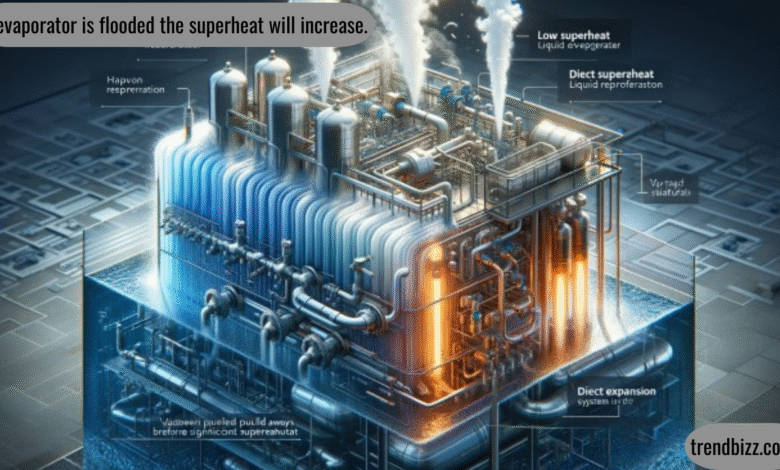Understanding the Refrigeration Myth: If Evaporator Is Flooded the Superheat Will Increase.??

Introduction: Debunking the Confusion Around Superheat and Flooded Evaporators
In the world of HVAC and refrigeration, precise control over refrigerant conditions is essential for system efficiency and longevity. A recurring question among technicians and students is: “If evaporator is flooded the superheat will increase.??” This topic often sparks debate due to a fundamental misunderstanding of how evaporators and superheat interact. In this comprehensive guide, we break down what flooding in an evaporator means, what superheat is, and why the statement “if evaporator is flooded the superheat will increase.” raises eyebrows among refrigeration professionals.
What Is Superheat in Refrigeration Systems?
Superheat refers to the temperature of a vapor above its boiling point at a given pressure. In refrigeration systems, superheat is typically measured at the outlet of the evaporator. It ensures that only vapor (and no liquid) enters the compressor. Maintaining proper superheat is vital because liquid refrigerant entering the compressor can cause severe damage. Superheat provides a cushion of vapor, safeguarding the compressor and helping to optimize system performance.
To measure superheat:
- Take the temperature of the refrigerant vapor at the evaporator outlet.
- Subtract the saturation temperature corresponding to the evaporator pressure.
This value indicates how much heat the refrigerant has absorbed after complete evaporation.
Understanding a Flooded Evaporator: What Does It Mean?
A “flooded evaporator” does not refer to an evaporator full of water. Instead, it means an evaporator receiving too much liquid refrigerant, more than it can evaporate efficiently. This condition leads to low superheat or even zero superheat, because excess liquid remains at the evaporator outlet. In some systems, especially those designed with a flooded-type evaporator (like in industrial chillers), this might be normal and desired. However, in most comfort cooling systems, a flooded evaporator signals a malfunction.
Common causes of a flooded evaporator include:
- A malfunctioning thermostatic expansion valve (TXV)
- Improperly adjusted TXV
- A plugged or dirty evaporator coil
- Refrigerant overcharge
The Misconception: If Evaporator Is Flooded the Superheat Will Increase.??
Let’s address the central confusion: “If evaporator is flooded the superheat will increase.??” The short answer is no—in fact, the opposite is generally true. When an evaporator is flooded with too much liquid refrigerant, it means there’s less space for the refrigerant to completely vaporize before it exits the coil. As a result, the refrigerant may still be in a mixed state (liquid and vapor) when it reaches the evaporator outlet.
Since superheat is measured only after the refrigerant has turned into vapor, the presence of liquid will lower the superheat reading, potentially to zero. So, a flooded evaporator leads to low or no superheat, not higher.
What Happens Physically During a Flooded Evaporator?
Let’s look at the physics: When an evaporator is flooded, the excess liquid refrigerant absorbs heat but doesn’t entirely vaporize within the evaporator. Because of this:
- The temperature of the refrigerant exiting the coil remains close to the saturation point.
- The superheat is minimal or nonexistent.
- Liquid refrigerant might carry over to the compressor (a condition known as liquid slugging), causing potential damage.
If you were to measure superheat under these conditions, it would likely be extremely low. Therefore, the claim “if evaporator is flooded the superheat will increase.” contradicts basic thermodynamics and field practice.
So Why the Confusion? Exploring Misinterpretations
There are a few reasons why someone might believe or state that “if evaporator is flooded the superheat will increase.”
- Terminology confusion – The term “flooded” might be misunderstood as more refrigerant means more heat absorbed, and therefore higher temperature and superheat. But the physics don’t support this.
- Measurement location errors – Technicians might measure temperature or pressure at incorrect points in the system, leading to inaccurate conclusions.
- Incorrect association with TXV behavior – Some may mistakenly think that a high load on the evaporator increases the TXV’s feed, causing an increase in refrigerant flow and higher superheat, when in fact, it should result in a decrease if flooding occurs.
What Actually Increases Superheat?
Superheat increases when:
- Refrigerant flow is restricted (e.g., from a partially closed TXV).
- The load on the evaporator is reduced, meaning less heat is available to vaporize the refrigerant.
- Refrigerant charge is low, leaving more of the coil surface underutilized.
In these scenarios, less refrigerant is available to absorb heat, so the vapor formed becomes significantly superheated. These are conditions opposite to a flooded evaporator.
Practical Implications: Why Accurate Superheat Measurement Matters
Understanding and accurately measuring superheat helps prevent:
- Compressor damage from liquid slugging.
- Inefficient operation, as low or no superheat can indicate oversupply of refrigerant.
- Service errors, where misdiagnosis could lead to unnecessary part replacements or adjustments.
A low superheat reading often suggests an overfeeding condition (possibly flooding), while high superheat suggests underfeeding. These indicators help technicians fine-tune system performance.
Summary: Setting the Record Straight
To conclude, the notion that “if evaporator is flooded the superheat will increase.” is incorrect. In fact, flooding the evaporator typically results in low or zero superheat, not higher. This misunderstanding can lead to faulty diagnostics and costly mistakes in HVAC servicing.
Let’s recap key points:
- Superheat measures the temperature above the boiling point of the refrigerant vapor.
- A flooded evaporator has excess liquid refrigerant that may not fully vaporize.
- This reduces or eliminates superheat, potentially leading to liquid refrigerant reaching the compressor.
- Proper understanding of these principles is crucial for system efficiency and longevity.
Final Thoughts: Precision Matters in HVAC
In refrigeration, details matter. Misinterpreting basic concepts such as superheat and evaporator conditions can lead to system inefficiencies and equipment damage. Technicians and learners alike should be clear on this fundamental rule: If the evaporator is flooded, the superheat will decrease, not increase.




